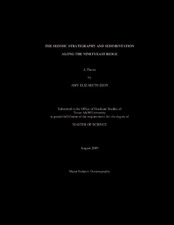| dc.description.abstract | The Ninetyeast Ridge (NER) is a ~5000 km-long aseismic volcanic ridge trending NS
in the eastern Indian Ocean basin. It is widely accepted that NER formed from the trace of
a single hotspot as the Indian plate moved northward during the Late Cretaceous and Early
Cenozoic due to the linear age progression from 43 Myo at the southern end to 77 Myo at the
northern end. What is not fully understood is the geologic history of the ridge since its
formation. This study examines the stratigraphy and sediment thickness on the ridge using
new seismic data to describe the sedimentary history of NER.
More than 3700 km of 2D multichannel seismic reflection profiles were collected
along NER at seven sites between 5.5 degrees N and 26.1 degrees S during cruise KNOX06RR of the R/V
Roger Revelle in 2007. Scientific objectives were to obtain site survey data for proposed
drilling and to understand the sedimentary layers, sediment distribution, and geologic history
of NER. Seismic survey sites were chosen primarily based on proximity to existing Deep
Sea Drilling Project (DSDP) and Ocean Drilling Program (ODP) drill holes (Sites 758, 216,
214, and 253) for interpretation and correlation with existing lithologic data.
Seismic data were processed (filtered, stacked, and time-migrated) and interpreted
using standard seismic stratigraphy principles. Three major horizons were interpreted, correlated with those previously recognized at the DSDP and ODP sites, and traced
throughout the seismic data. Seismic data were categorized into three units based on distinct
acoustic properties including changes in reflector amplitude, wavelength, continuity, and
geometry. Seismic Unit I comprises a succession of pelagic sediments and sedimentary rock
draped over Seismic Unit II, which consists of pelagic carbonates mixed with volcaniclastics.
Seismic Unit III is volcanic basement.
Sediment layer thicknesses and distribution were mapped at each site, and
bathymetric data were correlated with seismic data to interpret geologic features. Seismic
and core data indicate a common sedimentary history at each site: volcaniclastic-rich
sediments deposited during or shortly after ridge formation topped by a thick drape of pelagic
sediments. This history likely happened in three stages over the last ~77 My: 1) the initial
subaerial or submarine emplacement of the volcanic ridge, 2) the deposition of shallow water
sediments and volcaniclastics, and finally 3) the subsidence of the ridge followed by deep
water pelagic sediment deposition. | en |


